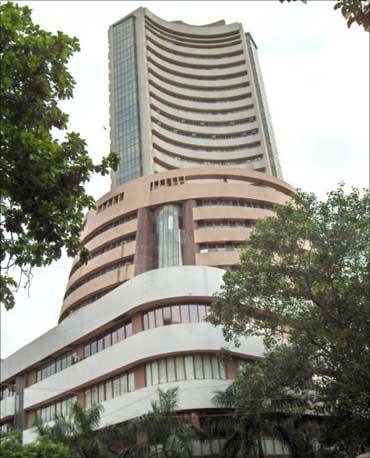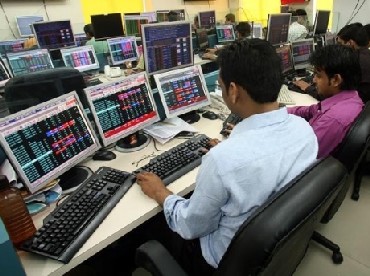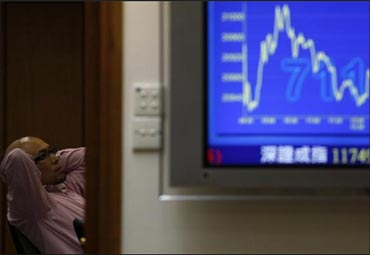Photographs: Reuters Devangshu Datta in New Delhi
It is relatively easy to make predictions about market directions in 2012. Technically, this is a long-term bear market. There are no signs of recovery.
Until there are some signs of a trend reversal, maintain a bearish attitude.
Trend reversal points
Let's set some chart benchmarks for recognising a potential reversal. The pattern of lower lows and lower highs will continue until the long-term trend reverses. As of now, the pattern of lower lows would be broken if the Nifty stays above 4,531. The pattern of lower highs would be broken if the Nifty climbs above 5,061.
A confirmatory signal would be the index rising above its own 200 Day Moving Average (DMA). The 200 DMA is currently between 5,225-5,350, depending on the mode of calculation. A positive crossover would lag actual reversal by many weeks.
. . .
Nifty: Bearish trend likely to continue in 2012
Photographs: Reuters
Support levels
What are the potential downsides if the bear market remains in force? Indian markets fit to the Fibonacci retracement levels. The last bull market started in October 2008, at a low of 2,257. It peaked at a high of 6,338 in November 2010. That meant an upmove of 4,086 points in 25 months.
Using Fibonacci ratios, this market has broken the first (23.8 per cent or 5,367) and second (38.2 per cent or 4,777) support. The next support is 4,295 (50 per cent) and below that, at 3813 (61.8 per cent) and 3,222 (75.2 per cent).
An analyst would look for intermediate rallies at each of these support points and he could hope for a full reversal.
In terms of pullbacks from the November 2010 peak of 6,338, this would mean successive drops of 32 per cent, 40 per cent and 50 per cent. The previous two bear markets of 2008 and 2000-2003 saw corrections of more than 50 per cent from respective peaks.
. . .
Nifty: Bearish trend likely to continue in 2012
Photographs: Reuters
Time projections
The time period of a major market trend can vary a lot. Relatively short trends can see large movements. For example, the 10-month bear market of 2008 saw a correction of over 64 per cent. However, for what it's worth, we can fit Fibonacci series to project time-periods when reversals are more likely.
The last bull market lasted 25 months. This bear market has lasted 13 months. It seems to have slid past the 50 per cent reversal zone of November-December 2011. The next critical turning points could come either in 15-16 months or in 19-21 months. Look for a reversal in the major trend around February-March 2012. If that fails, the next window is July. The February-March window could be triggered by a positive Budget.
. . .
Nifty: Bearish trend likely to continue in 2012
Photographs: Reuters
External indicators to watch out for
Any bull market must be driven by cash inflows. That means FIIs reversing their underweight stance. I'd look for a minimum two months of substantial FII inflows. This would probably follow only on some stabilisation of the Eurozone.
Valuation-based buying will only come on a change in the interest rate regime. The Reserve Bank of India will have to make two successive cuts, or a single large one, to give some confidence in looser monetary policy.
This would be a lead indicator and a revival of interest in equities would also be led by a healthier yield curve in government securities.
As of now, there is practically no difference between the 1-year T-bill yield (8.35 per cent) and the 10-year G-Sec (8.52 per cent).
In a bull market, there is usually a difference of 150-250 basis points between those two benchmark instruments. Look for the yield curve to widen before equity rises.
. . .
Nifty: Bearish trend likely to continue in 2012
Photographs: Reuters
Conclusion
The market could have a significant downside before there is any genuine reversal and revival. There is some chance of a reversal in Q4, 2011-12, given a good Budget.
Otherwise, Q2 2012-13 is a potential window. There are several clear benchmarks that would indicate an end to the bear market.
Until some of those are visible, be cautious, or go short.
The author is an equity and technical analyst.







article